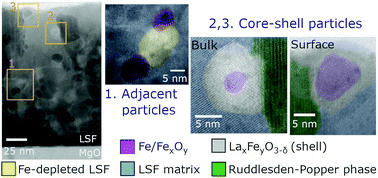Bulk and surface exsolution produces a variety of Fe-rich and Fe-depleted ellipsoidal nanostructures in La0.6Sr0.4FeO3 thin films†
Abstract
The past several years have seen a resurgence in the popularity of metal exsolution as an approach to synthesize advanced materials proposed for novel catalytic, magnetic, optical, and electrochemical properties. Whereas most studies to-date have focused on surface exsolution (motivated by catalysis), we instead report on the diversity of nanostructures formed in La0.6Sr0.4FeO3 thin films during sub-surface or so-called ‘bulk’ exsolution, in addition to surface exsolution. Bulk exsolution is a promising approach to tuning the functionality of materials, yet there is little understanding of the nanostructures exsolved within the bulk and how they compare to those exsolved at gas–solid interfaces. This work combines atomic- and nano-scale imaging and spectroscopy techniques applied using a state-of-the-art aberration-corrected scanning transmission electron microscope (STEM). In doing so, we present a detailed atomic-resolution study of a range of Fe-rich and Fe-depleted nanostructures possible via exsolution, along with qualitative and quantitative chemical analysis of the exsolved nanostructures and oxide phases formed throughout the film. Local structural changes in the perovskite matrix, coinciding with nanostructure exsolution, are also characterized with atomic-resolution STEM imaging. Fe exsolution is shown to create local A-site rich domains of Ruddlesden–Popper phase, and some stages of this phase formation have been demonstrated in this work. In particular, phase boundaries are found to be the primary nucleation sites for bulk and surface exsolution, and the exsolved particles observed here tend to be ellipsoidal with shape factor of 1.4. We report a range of nanostructure types (core–shell, bulk core–shell, adjacent, and independent particles), revealing several possible avenues of future exploration aimed to understand the formation mechanism of each exsolution type and to develop their functionality. This work is thus relevant to materials scientists and engineers motivated to understand and utilize exsolution to synthesize materials with predictable nanostructures.

- This article is part of the themed collections: Nanoscale and Nanoscale Horizons: Nanoparticle Synthesis and Nanoscale 2022 Emerging Investigators


 Please wait while we load your content...
Please wait while we load your content...